The Fall 2009 Anime Preview Guide
Carl Kimlinger
by Carl Kimlinger,
Fairy Tail
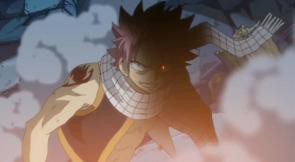
Rating: 3
Review:
Death, taxes, and super-powered teens who pummel evil—the three constants of the world. Honestly, no one really needs me or anyone else to tell them what to expect here. We've been reliving this experience for decades:
In a land of magic, Lucy is a Celestial Wizard yet to be enrolled in an official guild. Her heart is set on Fairy Tail, the wildest of the guilds, but she has no idea how to get in. In a port town she meets, and treats to a messy meal, an odd duck named Natsu. Natsu is looking for a dragon named Igneel, and while Lucy can't help him, when she's kidnapped by slave traders, he most certainly can help her. As fate (or the shonen gods of wildly unrealistic coincidences) would have it, Natsu is a Fairy Tail wizard. Who better to introduce Lucy to the craziest guild of them all than its craziest member? After he kicks some slaver ass, of course.
You know the movie Super Size Me, where the guy eats nothing but McDonalds for thirty days and turns into a bloated, apathetic, pate-livered wreck? If you did nothing but watch shonen action series, that's basically what would happen to your brain. That said, like a greasy hamburger, there's nothing wrong with indulging once in a while, and there's no denying it's tasty when you do. The fights are cool, the buffed-out lead is just unbalanced enough to be fun, and in a surprising move, Lucy is given a healthy slice of the action spotlight. Natsu may save her rear in a pinch, but she's plenty capable enough to reciprocate. Plus her astrology-based magic is a kick (her summoned creatures bad-mouth her). Amusing. In moderation, of course.
Yumeiro Patissiere

Rating: 3
Review:
The Tarsier, an Asian prosimian, has eyes twice the size of its brain. Kind of like Ichigo, Yumeiro Patissiere's heroine. That's a function both of her enormous eyes, and her minimal brains. Big glittery eyes and limited smarts are both traditional traits of shojo heroines, so as one might guess Yumeiro is a very traditional shojo fantasy.
Ichigo has always been overshadowed by her talented younger sister. Natsume is a brilliant young pianist while Ichigo is, well, a glutton. No athletic talents, no musical aptitude, and as mentioned, no smarts: Ichigo is in all ways an absolutely average girl. Even so she has her own dream. Ichigo wants to become a patissiere like her deceased grandmother, though she hasn't thought much about how to go about it. That changes when she attends a local sweets fair and her incredibly honed sense of taste (she is a glutton after all) catches the eye of an instructor from a famous pastry academy. And off she goes to a new life of sugar and, most likely, magic, romance and baking rivalry.
Yumeiro’s look is pure shojo fluff: limpid pools of eyes, dashing bishonen, curlicue hair—the whole nine yards. And its plot follows suit. The hopelessly average girl with the big dream, the flashbacks to her crybaby past, the discovery of her hidden talent, even the dead gramma—it's all straight from the shojo playbook. There're no fairies or reverse harems, but judging from the next-episode preview, that'll come in episode two. Rote as it is, it's pleasant enough, and Ichigo's relationship with her sister adds an emotional dimension that the series didn't need just to push pastries. That all may change once the series starts layering on the hunks and fairies, but for now, it's a sugary little distraction that won't harm any sensibilities.
Tegami Bachi Episode 2
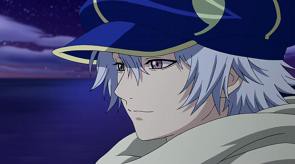
Rating: 3 ½
Review:
Beautiful settings and intricate costuming continue to create an enveloping fairy-tale ambience and the simple purity of its plot continues to appeal, even as Tegami Bachi as a whole fails to congeal into something compelling.
As orphaned Lag Seeing continues his cross-country trek with Letter Bee Gauche, the two naturally grow close. Gauche tries to distance himself, but the strengthening bond between the two is undeniable. Later Gauche is wounded saving Lag and Lag valiantly drags him miles to their destination. Once fully recovered, Gauche affirms his friendship with the one-eyed tyke and Lag swears to one day become a Letter Bee like Gauche.
There are suspiciously shonen-ish elements sprinkled throughout—Lag's dream to become a Letter Bee, his powered-up false eye—but the languid pace and quiet atmosphere set Tegami Bachi definitively apart from hyperactive action-fests of the Shonen Jump stripe. It's a deliberately slow and introspective show, far more interested in its characters and vaguely spooky fantasy setting than in its frankly cursory action. It can, and does, cross the line to maudlin and loves dropping specialized terminology (anime's answer to world-building), but it's also well-constructed and genuinely touching. That said, it has neither the insight nor the poetic bent of, say, Junichi Sato's forays into myth-building, nor does it have the compulsive watchability of the best serialized entertainment. Ultimately it's a good-looking, guilt-free diversion. Not something to be ashamed of, but nothing to cheer from the rafters about either.
The Book of Bantorra Episode 2

Rating: 4
Review:
Book of Bantorra’s follow-up to its gonzo opening suffers from its share of sophomore slump issues, but the potential of the still-tenuous relationship between its fledgling male and scary-strong female leads carries it through and at the end leaves one thirsting, like any good series, for episode three.
As Colio's little group of Church comrades whittles itself down as only a group of fanatical freaks with bombs in their chests can, the explosive disturbance they cause attracts the attention of none other than Hamyuts Maseta. The tragedies he witnesses, along with his continued interaction with the “witch's” Book, have planted the first seeds of humanity in Colio, but before they can bear fruit, Maseta arrives and begins systematically slaughtering every Church member in the city.
The cracks in the series’ budget are already beginning o show. This episode is noticeably less polished than the last, particularly during the action sequences. And the way it chokes on badly-integrated info-dumps almost immediately after the exhilarating confusion of the first episode is an eye-opener. The last time a series downshifted this abruptly was Shangri-la. Not a good sign.
But then there's that relationship. If it can even be called that. Hamyuts Maseta and Colio haven't even met by episode's end, but the series positively hums with anticipation of the encounter. It's a weird feeling, to be enamored solely of a series’ potential; but unlike so many other shows, the potential, the sense that you're waiting for something fascinating to blossom, is there. Only future episodes will tell whether that anticipation is foolish, but for now it's enough to make the wait for the next episode a cruel one. And that's a good sign.
11eyes

Rating: 2 ½
Review:
The suffocating sense of deja-vu sets in early. It isn't that 11eyes is a disgusting, despicable or even seriously bad show. It's got style aplenty and the smarts to make its characters likeable and its last minutes cliffhanger-ish. It's just the sameness of it. You can feel it: in the plot, in the designs, in the concepts. The plot concerns a one-eyed boy with mysterious and slowly awakening powers who is surrounded by strange girls and feeling the first rumblings of a connection to a terrifying alternate dimension. Sound familiar? Only because it's the basic plot (minus, maybe, the one-eyed thing) of every goddamn bishoujo game ever made. This is solidly executed and reasonably interesting stuff, but it isn't long before you begin to chafe at the maddening familiarity of it all.
Why, you ask yourself, must Kakeru's (the cycloptic protagonist) childhood friend Yuka have that lilting voice and weak-willed smile that scream “I'm fragile, protect me!”? Why does his chipper best friend have that simian look that says “please dismiss me as a romantic prospect”? Why are all of the mysterious people attracted to Kakeru's mysterious powers pretty girls? Why is everything that tumbles from anyone's mouth a moldy cliché? Why the alternate dimension? Why, in short, didn't anyone bother to exercise creative freedom? You want desperately to see the series break mold, just once to hear someone blindside you with an unfamiliar line or to be kicked from behind by a clever plot twist. But it never happens. And I'll lay odds it never will.
11eyes is currently available streaming on Crunchyroll.Darker Than Black: Ryūsei no Gemini

Rating: 4
Review:
Probably this season's most anticipated sequel after Kiddy Girl-and and Inuyasha Final, Ryūsei no Gemini begins in fine form with another tale of an ordinary person plunged into the extraordinary world of contractors and their handlers. The ordinary person this time is Suou, whose twin brother Shion is transformed one bloody night into a contractor. In the years since, her scientist father has been studying contractors and Shion has been confined to his prison-like room while Suou has been busy living the life of a normal girl and dreaming of visiting her mother in Japan. That ends the day her best friend Tanya also makes the shift to contractor and the Russian army descends on their town like a flock of buzzards. Suou escapes the chaos in the care of MI-6 agent April, only to run afoul of an old acquaintance of April's in the woods outside of town: BK-201.
Ryūsei no Gemini hits the ground running and barely lets up for a breath, only slowing long enough to introduce Suou before dumping her into the middle of a dark and very dangerous puzzle. The series makes fine use of its somewhat uneven first season, taking full advantage of the characters and world established during its rather slow start and the personal issues and human/contractor conflicts left unresolved by its hurried conclusion. Using Hei as the episode's bogeyman is a nice touch, and the contractor battles are as endlessly inventive and sadistically unpredictable as ever, not to mention freakishly cool. This is a sequel as they should be: a work that builds on what came before without losing what made the original work. Smart, engrossing stuff; not to be missed by anyone with a taste for action and intrigue.
Shin Koihime Muso

Rating: 2
Review:
Shin Koihime Muso has that exact mix of mild charm, shoddy execution and even shoddier writing that creates series with precisely zero impact. Part of an alliance of flashy female warriors who put bandits and other bad elements in their place, Bachou is the alliance's token barbarian, a crude, gluttonous and yet supremely skilled warrior. Her best friend is diminutive but equally gluttonous Rin Rin, a tiny little firecracker who rides a cute pig into battle. After a hard day's bandit-busting, everyone heads to the local inn to unwind. There Bachou gets it in her head to call Rin Rin by her given name, but to her horror just can't seem to do it. Rin Rin notices Bachou's odd behavior and misinterprets it as homesickness, causing all manner of sulky mayhem.
There are no words to describe how lame Koihime Musou’s battles are. For an ostensibly action-oriented show, it has precious little concern and even less flair for spectacle or excitement. It's opening fight is flatly animated, poorly orchestrated, and completely devoid of enthusiasm. It shows infinitely more enthusiasm for the relationships of its all-female cast. Of particular interest this episode is Bachou and Rin Rin's cute friendship; but even that is undercut by lazy writing and forced energy. You know a show's in trouble when Sgt. Frog can resolve the exact same dilemma (with the same solution by the way) in half the time and with twice the charm. And so it goes. A good quality will raise its head, only to be swatted down by something irritating, stupid or plain bad. And at the end of the equation, the sum is always the same: zero. It's almost enough to make you yearn for the shameless raunch of Queen's Blade. At least that left an impression.
Shin Koihime Muso is currently available streaming on Crunchyroll.Kimi ni Todoke

Rating: 5
Review:
Sawako's life is a mess of misunderstandings. With her long black hair and awkward demeanor she's gained a reputation as a supernatural menace. Rumor has it that she can speak with spirits and that anyone who holds her gaze for more than three seconds will be cursed. In truth, though, Sawako is a kind and exceptionally considerate girl, just with the looks and social graces of a gothic monster. The only person who seems to understand this is Kazehaya, the boy Sawako looks up to as an ideal of friendliness and “pleasantness.” Emboldened by Kazehaya's understanding, Sawako makes an effort to open up to her classmates and is positively shocked when she ends up making real friends.
This is a good season to be a fan of romance. Between Sasameki Koto and this little gem, there's an absolute embarrassment of romantic riches floating about this fall. Make no mistake, though, the two are very different series. Where Sasameki is steeped in sadness, Todoke is overflowing with sun and sugar. And not in a strident or phony way either. The series has a gentle, pleasant rhythm and is generous and kind with its characters without glossing over their faults. It also has a balanced sense of humor and an appealingly clean look, not to mention some sharp designs. However its true weapons are its main characters. Sawako and Kazehaya are a bracingly optimistic couple with a powerful and unusual chemistry based, shockingly, on mutual kindness and understanding. The series deserves kudos if only for handing such plum roles to Mamiko Noto and Daisuke Namikawa, a pair of prodigiously talented actors who have all too few opportunities to play romantic leads. High-school romance has never looked or felt so good.
Sasameki Koto
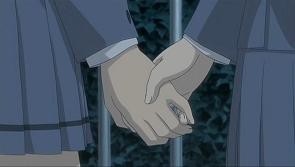
Rating: 5
Review:
Less refined but harder hitting than last season's lovely Aoi Hana, Sasameki Koto is a perceptive tale of teen romance complicated by same-sex love. Sumika Murasame, Sumi to her friends, is her class's president and resident cool-headed beauty. Her best friend Ushio Kazama is the class's resident airhead. Ushio is an unabashed lesbian with a taste for cute—emphasis on the cute—girls and a habit of falling quickly in and out of love. Though the “out” usually involves one-sided heartbreak on her side. So focused is she on her romantic pursuits that she misses completely the obvious fact that Sumi is completely and irrevocably in love with her.
Maybe it's my Catholic upbringing, but I'm a sucker for self-sacrifice. Watching Sumi suffer silently as her best friend unknowingly breaks her heart strikes a chord deep inside that is probably indicative of all manner of unhealthy issues. But even without the twisted martyr complexes, this is a stunningly accomplished drama that will appeal to a large variety of substance-starved romance fans. This first episode so subtly yet completely lays out the relationships, emotions and inner conflicts of its cast that it's almost hard to see it where it can go from here. Like Aoi Hana, it deals with homosexuality as part of a complex real-world milieu, creating an intricate web of affections and emotional consequences that it doesn't hesitate to exploit to aching effect. And Sumi…Sumi is one of the most nuanced and coolly sympathetic heroines to ever grace a lowly teen romance. Absolutely superb.
Sasameki Koto is currently available streaming on Crunchyroll.Tentai Senshi Sunred Season 2

Rating: 3
Review:
Need something dippy and harmless to wash away the intellectual aftertaste of all that rigorous and demanding anime you watch? Then Sunred’s the anime for you. There's nothing like watching the latest adventures (if you could call them that) of everyone's favorite sentai misanthrope to empty your head like an upended bucket.
As per usual, nothing whatsoever happens this episode. Nearly the entire thirteen minutes is spent watching supervillain General Vamp make and break his appointments with Sunred (for a death-match, of course), much to the not-quite-hero's vocal displeasure. A few minute-or-less vignettes (Vamp's plushie sidekicks being teased by neighborhood brats for instance) polish the episode off and—voila!—your brain is in a state of pleasant stasis.
Pleasant because, while the show is systematically disabling your thought processes, it's also being mildly, indeed pleasantly, funny. The humor of the series is derived largely from the fact that the hero is crude, petty and destructive while the villains are polite, generous and constructive; with some well-played parodies thrown in for good measure (Sunred's old sentai group the Weather Three are a kick). Pleasant is as far as it goes, though. The artistry is pretty crude, the character interactions are a literal joke, and the laughs never rise above an indulgent chuckle.
Kobato
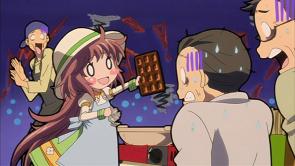
Rating: 4
Review:
How to make the magical girl genre feel fresh again? Well, borrowing a gentle page from Aria’s magical-realist playbook, corralling some genuine visual poetry and using it all to back one of the most instantly loveable characters in recent memory would be a start.
Like all magical girls, Kobato has come to the human realm to collect something. In her case, scarred hearts. And like all magical girls, Kobato has a dream and a magical mascot. Unlike most magical girls, though, Kobato has no magic. She has only her warmth and honest desire to help those in need. Both get her into a great deal of trouble once she arrives on Earth, particularly as they are coupled with childlike naiveté and an unquestioning trust in others. Luckily her cynical, fire-breathing mascot Ioryogi is on hand to fend off the riffraff. Not so fortuitously, he's also looking to test her on her ability to make do in human society. If she doesn't pass, she can't collect hearts, and as she has common sense the way Pomeranians have scales, her quest may be doomed from the start.
The ladies of Clamp are past masters of tweaking genre formulas to their peculiar needs, and Kobato is no exception. You can smell the secrets that they have squirreled away behind the series’ magical girl façade and you can see their hand in the streak of cold reality that tempers the cuddly magical-girl cuteness and the deftness with which the series sketches its characters. That said, none of that matters in this inaugural episode. This episode is all about Kobato herself, and she nearly single-handedly transforms it from something shopworn into something sweet and moving. The prospect of scarred-heart-of-the-week episodes to come looms large, but if they leave you feeling like this one does, then frankly who cares.
Nogizaka Haruka no Himitsu Season 2

Rating: 2
Review:
Before Boris Karloff turned him into a big cuddly baby, Frankenstein's Monster was conceived as an undead being that was like man and yet not a man, a creature created from a pile of deceased flesh that could walk and talk and think, and yet that any observer could see was somehow off. Which is more or less what Nogizaka Haruka no Himitsu is.
Eternally perfect uber-girl Nogizaka Haruka's secret is that she is, under her honor-student surface, a raging otaku. Last season unremarkable everyman Yuuto stumbled across her awful secret but resolved to keep it under wraps as long as she wanted him to. The two have since grown close, and season two finds them going to a hot spring with their friends. Haruka's maid team joins them on the way, determined to get the two some quality lovey-dovey time alone together. Not an easy task when Yuuto is so busy being wooed by Shina and getting stuck in the women's bath.
You can almost see the stitches where Haruka cobbled together the dead limbs and organs of older, better shows to create its horrifying simulacrum of a living romantic comedy. A basic relationship from Oh! My Goddess, a class barrier from Ai Yori Aoshi, a maid team from (where else) Hanaukyo Maid Team, a character design from Love Hina, a teeming platoon of overworked situations from dozens of previous romances—all dragged from their graves and made to dance in an infinitely inferior parody of their previous lives. Even the addition of shiny new moe overtones and a trendy otaku focus can't hide the musty smell it gives off, and nothing can obscure how empty, hollow and phony the whole thing feels. Like the Monster, it moves and speaks, but the soul just isn't there.
Nogizaka Haruka no Himitsu 2 is currently available streaming on Crunchyroll.Sora no Otoshimono
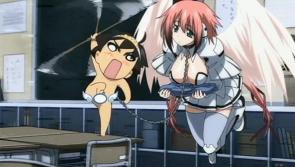
Rating: 1
Review:
You know those nightmares where you get up in front of your class to do a presentation only to realize that you're stark naked? Given the choice to live that nightmare or watch Sora no Otoshimono…well, I'd probably go with Sora no Otoshimono. But only by a hair.
Scrawny twerp Tomo has a recurring dream about a winged girl who leaves him to live in the sky. When he asks a warped classmate about it, he is sent to a nighttime rendezvous with a black hole-thing, from which falls a (different?) winged girl who instantly imprints on him and promises to do anything, anything he wants her to. Let the rampaging of the libido begin.
There's wish-fulfillment and then there's diseased fantasy. This is the latter. When Ikaros imprints on Tomo, a chain sprouts from her collar (yes, she wears a collar) and wraps around his hand. He spends the rest of the episode literally leading her around by a chain. That is when he isn't ogling her, telling her to strip, and almost (but not quite, he is a good guy after all) forcing himself on her. And that's before Tomo discovers that Ikaros can stop time and render him invisible. After watching Tomo run amuck like a naked, invisible SD leprechaun groping and stripping panties off of unsuspecting girls, you'll need a bucket of soap and a scouring pad to feel clean again. And to add insult to injury, the episode tries to take an emotional turn at the end (no, seriously) that leaves its stinky, sticky fingerprints all over every heartstring it tries to pluck. Never have I been so ashamed to be a man.
Sora no Otoshimono is currently available streaming on Crunchyroll.Miracle Train

Rating: 2
Review:
A deeply weird combination of education for kids and wish-fulfillment fantasy for girls, Miracle Train is by far the strangest series this season (at least so far). The Miracle </>Train of the title is a magical train that runs through Japan's Oedo Line and is only accessible to troubled young women. On it are a bevy of young men, each a gorgeous personification of a station on the Oedo line, and every man jack of them devoted to solving the problems of worried women. Chinatsu is on her way to the vet when her dog escapes his holder and she somehow ends up on the Miracle</> Train. Can Roppongi, the kindhearted personification of Roppongi station, find her dog and heal the underlying hurt in her heart? With a face like that, how can he not?
Like broccoli dipped in chocolate, this attempt to wrap wholesome education in sugary entertainment does neither any favors. The fan-pandering is brought to a screeching halt with each expository speech, and unless you're among the fans being pandered to, you'll find the entire exercise so preposterous that the educational asides about Oedo Line (built in 2000, it twists around many older lines) and its stations (at 42.3 meters, Roppongi is the deepest) won't stick. Better to keep your veggies and your dessert separate. The series does have a pleasantly deadpan sense of humor that lets you know it doesn't take itself too seriously, but still.
Miracle Train is currently available streaming on Crunchyroll.Inuyasha: The Final Act

Rating: 3
Review:
With the assistance of wind demon Kagura, Hakudoshi plans to help Moryomaru, who houses within him Naraku's expelled heart, acquire enough power to overthrow their mutual creator. Where to get the necessary power? Why the Shikon Jewel of course. As they have in their possession the only extant shards of the jewel, Inuyasha's band comes instantly under fire. The resultant clash leaves all parties playing right into Naraku's scheming hands.
Back in 2004, Sunrise made the wise decision to cease animation of Inuyasha until enough original material was compiled to justify reviving it. Five years later, Takahashi's manga has finally run its course and Sunrise has carefully reassembled the original cast and crew to bring the franchise's last remaining stories to the small screen. For the fans who have been waiting with bated breath for the beast to rear its head once more, this will be mana from heaven: pure canon bliss, with more advancement in a single episode than many of the previous seasons saw in their entire runs. For the less scrupulously faithful, or the plain forgetful, though, this will be a thirty-minute whirlwind of unadulterated confusion.
Since its humble beginnings as a “feudal fairy tale”, Inuyasha has become a colossally convoluted monster, and this episode drops us with no preparation into the middle of the miasma. Moryomaru is a demon who ate the demon who sprang from the half of Hakudoshi that had within him Naraku's heart which Naraku had expelled in order to…oh f***. Who the hell can keep up with that after a five-year gap? This is one for the fans—and only the fans. The production's impeccable tho.
Inuyasha: The Final Act is currently streaming onHulu and ShonenSunday.com.Seitokai no Ichizon
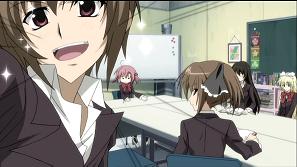
Rating: 1 ½
Review:
Seitokai no Ichizon begins with its characters bashing the manga they were adapted from. It's a heady couple of minutes; wildly self-referential and very funny, full of obscure anime references and sly, self-deprecating humor. It's also the best the episode gets. As it turns out, the characters were right: their show sucks.
The story, as such, revolves around the Heikyou academy Student Council. The Student Council is chosen by popularity vote, which naturally leads to a Council of pretty girls. The sole exception is Sugisaki Ken, an eroge-obsessed pervert who got on the council by dint of being the school's valedictorian. The Council meets daily, at which time the meeting quickly self-destructs into a series of discussions about nothing of importance. The end.
One room, four bishoujo stereotypes, one hell-bent harem otaku, and a half-hour of endless nattering. If Satan needs to devise a torture to match my sins, this is it. There are just enough throwaway anime references and incidental jokes to keep the show from sending me to his Princely Darkness early, but not enough to keep the show from stretching out into an interminable spiral of meaningless chatter. Like the snake eating its own tail, the conversations go round in circles until they disappear, leaving benumbed viewers to wonder at the vacuousness of it all. Never has a mere twenty-odd minutes seemed so damnably long.
Nyan Koi

Rating: 3 ½
Review:
A romantic comedy that works as a comedy? What's next, the plague of frogs, or the flaming hail? Nyan Koi's humor works because it isn't really related to its romance. In fact, romance barely comes into this first episode at all.
Irresistibly tempted by the proximity of an empty can to a garbage bin, obligatory normal high-school student Junpei attempts a hole-in-one can-to-bin kick. Newtonian physics lapse just long enough for the can to ricochet into a nearby statue, neatly severing its head. Unfortunately the statue happens to belong to a vengeful cat spirit, who promptly curses poor Junpei. Cursed with the ability to understand the language of cats, Junpei soon learns that he'll have to help one hundred cats or he'll turn into one himself. Not such a bad prospect for a normal person, but Junpei also happens to have an acute cat allergy. Horrified at the idea of dying from an allergic reaction to his own fur, he sets out to right the wrongs of neighborhood cats.
Aside from Junpei's obvious attraction to cat-loving cutie Mizuno, there's precious little romance here. That's a good thing. The series has an energetic, inventive sense of humor and sidelining the mushy stuff lets it stand tall. The can-kicking is staged as a sci-fi encounter—complete with targeting data and computer commands—and the cats, once their language is unraveled, think and talk exactly as cats would. Junpei makes for a funny and sympathetic lead, and even Mizuno gets into the act (inadvertent cat torture: always funny). Of course the real test is whether the series can dodge the twin rom-com curses of harems and lazy ecchi humor, and that...well that remains to be seen.
The Sacred Blacksmith

Rating: 3
Review:
Ever come to and realize that you have a half-hour hole in your memory? Doctors call it a blackout. I call it The Sacred Blacksmith.
In a vaguely medieval fantasy-ish land, newly-minted knight Cecily Campbell is doing her best to live up to her new position in life. When it comes to setting over-enthusiastic merchants to rights she does well enough, but once she is faced with actual battle everything falls apart. Sword shattered and alive thanks only to the timely intervention of magical blacksmith (and crackerjack swordsman) Luke, Cecily decides, screw training, what she really needs is a better blade. So she sets out to find the best blacksmith in the land, which quite naturally happens to be Luke.
Surprisingly, given that it springs from the same animation loins as Samurai Champloo and Michiko to Hatchin, The Sacred Blacksmith is a complete nonentity. It's generalized fantasy of the blandest sort, with nothing—not character, not setting, not even (and this is a shock coming from manglobe) action—to distinguish it from a million other RPGoid fantasies. It's one advantage is its tasty character art (slender yet pleasingly proportioned, with that clearness of eye and cast of the lips that says “manglobe”), but that is zeroed out by Cecily, a purportedly strong female lead who has to be rescued by the hero not once, not twice, but three times. Is that some kind of snide commentary on women's lib? And it doesn't help that Luke is a bit of a dick. Not that any of that is enough to make it a bad series—no, that would be memorable. Instead it's just a…blackout.
Tegami Bachi

Rating: 3 ½
Review:
Get your fairy tale fix right here. In Amberground, a world of permanent twilight, letters are the preferred form of communication. The delivery of letters is a crucial job undertaken by highly trained specialists called Letter Bees. Armed with unique weaponry and accompanied by Dingoes (guide beasts, not the baby-stealing dogs of the Australian Outback), they trek through wastes infested with enormous mechanical beetles to deliver the citizens’ precious packages. When Letter Bee Gauche arrives at the pick-up location for his next delivery, he finds only a scorched ruin and a child chained to a cross. The child is Lag Seeing, and as fate would have it, he's Gauche's letter.
A child's bedtime story brought to life by the miracle of modern animation. The simplicity, the sadness, the wonder—it's all there, along with the artificial dialogue, explanatory passages, and slightly pokey pacing designed to send drowsy tots (and uninterested adults) off to dreamland. Anyone looking to cleanse the palate after a hard day of convoluted ninja politics would do well to hearken up. Refreshingly basic without sacrificing emotional undertones or backstory, it's delivered at a pitch that finds a relaxing mean between the childish and adult. Unfortunately it's also saddled with too much “Terminology”, and is almost certainly doomed to devolve into a series of standalone tales with mildly depressing messages. On the upside, the opening animation promises an adorable sidekick in the near future.
Tegami Bachi is currently streaming on Crunchyroll.White Album Season 2

Rating: 2 ½
Review:
The industry's habit of splitting what previously would have been a full 26-episode series into two arbitrary 13-episode seasons finds its latest victim in White Album, a series also victim to the vogue for sluggish visual-novel-based romances.
Yuki's singing career is flourishing. More public exposure, though, means less time for her alienated boyfriend Toya. And with his father hospitalized with heart trouble, he has less time for her. As the two drift apart, Toya's childhood friend Haruka drifts closer to Toya's troublesome tutoring charge Mana while she in turn continues drifting away from her neglectful show-biz mother. Life, in short, is crap all around.
Your enjoyment of White Album’s second season will depend pretty much entirely on your tolerance for humorless romances with ill-natured yet colorless male leads. Myself, if I see one more girl crying in the snow over how empty her life is without her resident asshole, I'm going to swallow a shotgun. That said, with thirteen episodes of girls moping in snow already under their belt, anyone watching this will already know whether it's their cup of cold, bitter tea or not.
And in all honesty, amongst humorless romances with ill-natured yet colorless male leads, White Album is top-shelf stuff. It's stylish and mature; well-animated and as well-written as can be reasonably expected. Its music industry milieu is interesting (and heartlessly realistic) and its setting carefully realized (1980s Japan; dig the suitcase-sized satellite phones). It's also relentlessly gloomy and takes itself far too seriously, but if you didn't know that going in, then this isn't aimed at you anyway.
The Book of Bantorra

Rating: 4 ½
Review:
The Bantorra Library is no run-of-the-mill book-lending establishment. It's a repository for books that have been shaped from the souls of the dead. Each is a precious testament to the lives of their creators, a priceless treasure that the Bantorra librarians are willing—and very able—to defend with lethal force. Led by ruthless raven-haired beauty Hamyuts Maseta, the “armed librarians” count among their foes a mysterious religious sect that robs innocents of their will, turning them into what the less empathetic call “Meat”. During a raid on one of the sects ships, one of the soulless encounters a fragment of a book forged from the soul of a beautiful woman who also happens to be an infamous mass murderer.
A tad confusing and hugely intriguing, Tatakau Shisho is intelligent fantasy for mature tastes: filled with tantalizing fragments of a well-realized world, anchored by a powerful, ambiguous female lead, and colored with a hint of trenchant social commentary. Sure the super-powered librarians are straight from a shonen action vehicle and there's at least one obvious info-dump, but they are minor and forgivable flaws in an opening episode full of fresh ideas and unforgettable imagery (a seaborne kamikaze assault by soul-drained minions with bombs in their flesh, a beautifully textured flashback, an empty room in which men are robbed of their humanity by a gramophone). Plus, who could resist a series whose male lead starts off as a literal lump of meat? Talk about potential for character growth.
The Book of Bantorra is currently streaming on Crunchyroll.To Aru Kagaku no Railgun

Rating: 4 ½
Review:
Those who had the good luck or sense to watch 2008's highly polished To Aru Majutsu no Index will remember Misaka Mikoto, AKA “the Railgun.” She's the level 5 esper that Index’s Kamijou tangled with in episode one, and later helped out of a seriously ugly human experiment. She was one of Index’s most interesting and underrepresented characters, and the folks behind the series had the good sense (or luck) to base this spin-off series entirely around her.
With a cast composed equally of past favorites (Misaka's overly amorous roommate Kuroko) and intriguing newcomers (plucky level zero Saten), a comely balance of humor, fan-service, character and raw adrenaline, and a sleek, attractive look, Railgun is as perfect as anime action gets. The plot of this first episode is simple—Misaka meets and goes out for crepes with Kuroko and her friends only to have their date rudely disrupted by a bank robbery—but the enjoyment derived from it is anything but. Director Tastuyuki Nagai (Toradora, Honey and Clover II) has an undisputed talent for character interplay and economical emotional insight, as well as a wholly unexpected instinct for jaw-dropping action, and the series he crafts is simultaneously thrilling and heartwarming. Escapist entertainment of the highest order.
Asura Cryin’ Season 2

Rating: 2 ½
Review:
Less a sequel than a direct continuation of the first season, Asura Cryin’ kicks off its second season with its usual ill-blended mix of apocalyptic sci-fi, teen angst and dumb rom-com humor.
The relative peace of Tomoharu's new life is disrupted by the arrival of a koala. While washing the pool as punishment for being a boy in a shonen romance, Tomo is forced to abandon his duties when Ania follows a bipedal koala into the sewers below the school. Tomo and his usual retinue of female company go to help her and everyone ends up lost in the pipes. With no option but to follow the koala, the group ends up in a series of underground ruins where Misao's interaction with a glass sphere triggers a flashback in Tomoharu that hints at a past (future?) that he knows nothing about.
The show's science-fiction nature has grown into a reasonable draw—throwing out moderately interesting ideas often enough to keep the series afloat—but the show as a whole still suffers from a wildly inconsistent tone. The end-of-humanity prognosticating and identity issues are an uncomfortable fit with its shiny everyanime look, and the harem situations (“Eek! You saw me getting dressed! Pervert!”) and sadly ineffectual humor detract rather than add to the series. In short, it's business as usual. The koala is pretty cool though, as are Angela's opening and ending themes.
Asura Cryin' 2 is currently streaming on Crunchyroll.
Kämpfer

Rating: 3
Review: Who, when our ancestors first descended from the trees, would ever have thought that after millions of years of evolution and hundreds of thousands of years of accumulation and refinement of wisdom, we'd one day concoct a gender-swapping, ecchi magical action harem comedy. Our hairy, knuckle-dragging progenitors would be proud.
The plot, or what passes for it, goes something like this: one day Natsuru, a perfectly normal teenager, awakes to find that his grotesque stuffed anime (Harakiri Tiger, complete with dragging entrails and trickle of blood from the mouth) has given him a bracelet that transforms him into a super-powered, super-endowed woman. He's told he must fight (why? Who? Who knows) and that when his bracelet glows he's about to transform. Gunfights and hijinks ensue.
Vitriol and instinctive recoiling aside, Kämpfer turns out to be not quite as awful as it could have been. It's lively and doesn't take itself too seriously—both advantages—and, let's not kid ourselves, the prospect of girl-on-girl action can lend luster to even the most preposterous, dimwitted and downright putrid of ideas. This will never be anyone's idea of respectable entertainment (the scene in which Natsuru does battle with his female bladder comes to mind) and it could self-destruct into a hormonal heap of pseudo-hentai harem clichés at any moment, but it's helmed by Yasuhiro Kuroda, the man behind the memorably fun Kyōran Kazoku Nikki, and packed with energetic (if none-too-expert) action, so yes, things could definitely be worse.
Queen's Blade: Gyokuza no Tsugumono
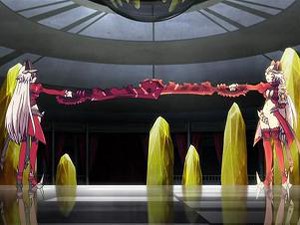
Rating: 2
Review: The remaining contestants in the Queen's Blade tournament are all gathering in the city of Gainos, remembering battles and grudges past. With the free-for-all for strongest Amazon heating up and the Queenhood of the continent up for grabs, Heaven makes its move and sends Nanael to join the fray. Elsewhere young Leina worries about the possibility of battling her sisters, while evil queen Aldra fends off an attack by a certain lactating rabbit-girl and characters major and marginal reminisce and rest up for the battles to come.
After a first season of more political complexity than one would expect from a show so resolutely proud of its sordidness, Queen's Blade gears up for a second round of tits, ass, and ass-kicking. Though the t & a may have to wait a bit. There're so many characters to reintroduce and so much plotting to plot that this episode only has time for one girl-on-girl groping and a solitary tentacle rape. Sure the extensive cast of blimp-breasted bimbos spends more time naked than clothed, but seriously, the folks at ARMS are going to have to do better than that if they want to keep their core audience satisfied. Exploitation for those who like their exploitation without pretense.
discuss this in the forum (327 posts) |
this article has been modified since it was originally posted; see change history
back to The Fall 2009 Anime Preview Guide
Season Preview Guide homepage / archives